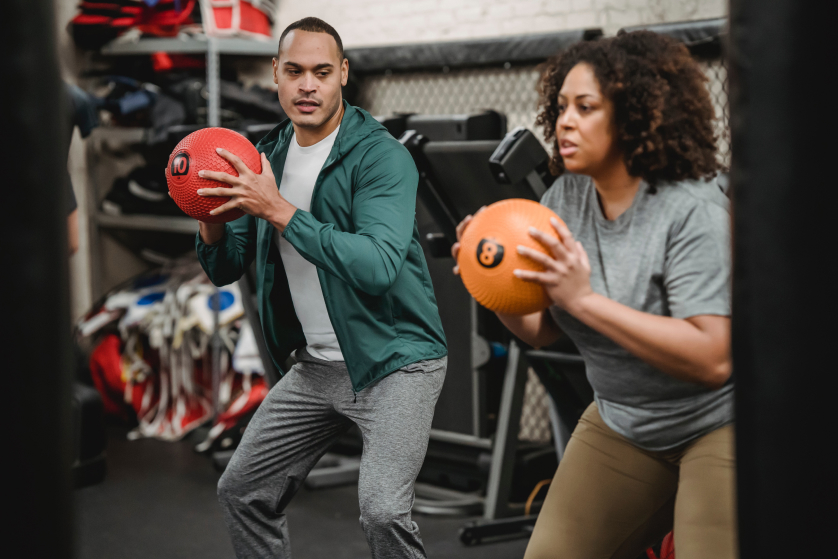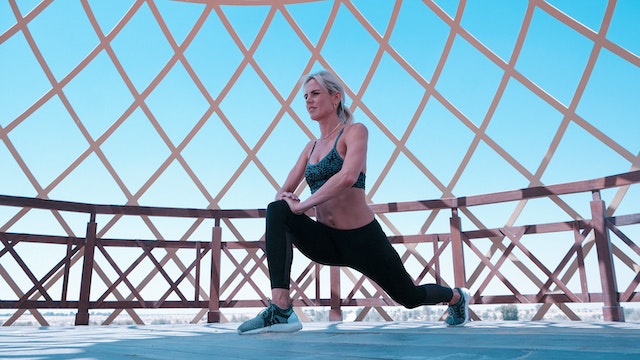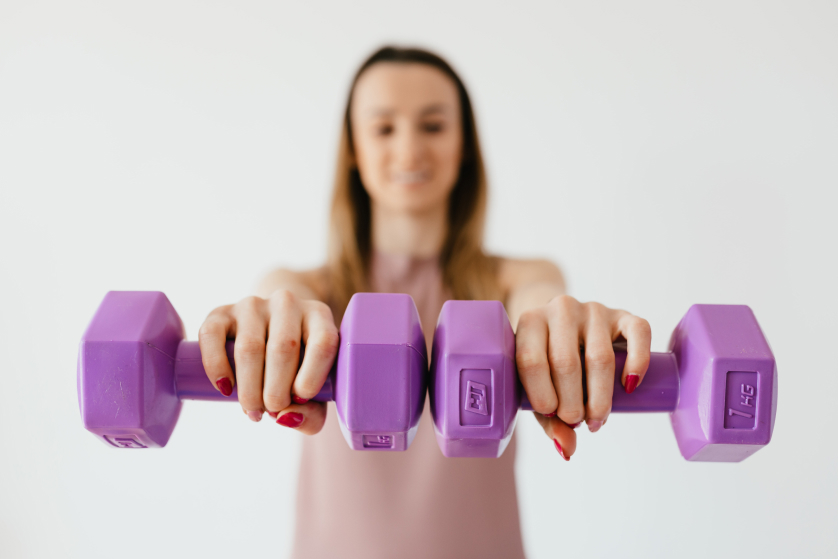
Written by
Tatyana Marchenko
Professional trainer, physical education teacher, master of sports in rock climbing.
Professional trainer, physical education teacher, master of sports in rock climbing.
Published
15 articles
Table of contents
Catch a bus without getting out of breath, carry a heavy bag of groceries home without falling into a chair from back pain - life tests our physical strength every day. Typically, when performing most everyday movements, we use muscles that are different from those we train using the exercise machines.
Functional training solves this problem. Classes are a mix of cardio and strength training. Functional exercises train the body and facilitate the natural movements that we perform at home and at work. They involve all muscle groups - large and small, superficial and deep. They help you lose weight, gain relief, make your figure slim and athletic, and even change the quality of your skin for the better.
At the same time, functional training is universal. It is suitable for people of any age, level of training, and health.
The word functional in “functional training” indicates that the exercises are related to the functions that a person performs. Simply put, with everyday movements.
You leave the entrance and push a heavy door, bend over, picking up a fallen object from the ground, balance on a slippery surface, carry a baby in your arms, etc… - by performing all these functional actions, you use several large muscle groups at once. It is impossible to simulate such movements on a simulator. While the emphasis on functional training is placed on those movements that we use in everyday life - squats, lunges, bends. This is the main advantage of functional training.
After all, you can disappear for hours in the gym, pumping up your deltoids, core or lats, and be completely unprepared for the loads that you encounter day after day. Or you can download a mobile application with home workouts to your phone and enjoy a high-quality functional workout without leaving your home.
Regular functional exercises help develop the physical qualities that are necessary in everyday life.
A moderately high pace of aerobic exercise increases the pulse and quickens breathing. The heart muscle begins to work more intensively, pumping blood through the vessels faster. The endurance of the cardiovascular system and the body as a whole increases.
The exercises work the large superficial muscles, as well as the small stabilizer muscles. The latter do not work dynamically, their function is to ensure the fixation of the skeletal parts relative to each other. Thanks to them, you better maintain stability when performing different movements.
A medium and high tempo of performing exercises makes functional training intense, movements take on an explosive character, speed and reaction times improve.
Training includes a number of strength exercises. A gradual increase in load and exercises with free weights (dumbbells, barbells, kettlebells) have a positive effect on the growth of muscle mass and muscle strength.
The vast majority of functional exercises are basic - multi-joint, that is, all large muscle groups are involved in the work. Not only the superficial muscles, but also the deep muscles receive the load. Joints become more flexible and muscles become more elastic.
Another advantage of functional training is fat burning. Intensive training speeds up metabolism, increases energy consumption by the body, and fat serves as fuel. As a result, the amount of fat, and with it excess weight, decreases.

For the overall development of the body, functional training is the best option. But if we are talking about achieving specific results in certain sports, you need to focus with those goals in mind. Functional training alone is not enough. For example, if you want to break the sprint record, you would need to run 100 and 200 m. If you want to jump a triple over 17 m, focus on jumping a triple. If you want to improve your bench press, train with bench press.
When using the HIIT (high-intensity training) format, those who are very overweight, should especially monitor their health. If you have other health problems, we also recommend consulting with your doctor. Fitness, first of all, should be beneficial, so the load for risk groups should be selected wisely, without harm to health.
The variety of training types is one of the great advantages of functional training. You can train at home, outside, in the gym, and during business trips in the hotel. You can use weights or work solely with your own body weight, use dumbbells and fitness bands, or just go for a run.
But there are common features that are inherent in all types of functional training.
Functional exercises are multi-joint, basic. When they are performed, several large muscle groups and joints work at once. Basic complex exercises teach muscle groups and joints to work together for greater efficiency. Joint work, which involves different muscles and several joints, is most effective both for burning energy and for pumping up the whole body.
Functional training includes working with free weights. What does it mean - free weights? It means that the equipment is not fixed, as when performing exercises on most exercise machines, and the trajectory of movements is determined by the biomechanics of the body. That is, when performing an exercise, the body makes the correct muscle movements. The muscles move physiologically - along the trajectory that is natural for them, and not set by the exercise machine. The important everyday skill of maintaining balance, pulling, pushing and carrying heavy objects is pumped up. As a rule, the classic trio is used as free weights: kettlebells, dumbbells, and a barbell. When training at home, an alternative to them can be bottles of water, a backpack filled with books, and other items for organizing a home workout.
Functional training is often conducted in the format of circuit training. Exercises are performed in a circle: one follows another, with a short break. Then the circle is repeated. But it cannot be said that interval training is an obligatory component of functional training. However, because it saves time and allows you to achieve brilliant results, especially when losing weight, the circuit format is most commonly used.
Strength training is part of the functional training program, however the goals may be different. Strength training is focused on the development of specific muscle groups, bodybuilding. Functional training emphasizes on developing a harmonious body and improving all those qualities that a person needs in everyday life. Accordingly, the tools for achieving results are also different.

In strength training, work is focused on building up certain muscle groups. Also, strength training is characterized by the inclusion of isolation exercises in the program, when a specific muscle receives a targeted load. All functional exercises are complex, basic - several large muscle groups and joints work together at once.
One of the main advantages of functional training is its physiological nature. Low load on the spine, gentle exercises in relation to ligaments and joints reduce the risk of injury. Strength exercises are often performed at the limit of capabilities, under tension. This requires perfect technique and adequate load. Failure to comply with these conditions is fraught with injuries.
Regardless of the type of training, any activity - cardio, strength or other type of fitness - begins with a warm-up and ends with a cool-down - stretching exercises. And running around the apartment or outside for a couple of minutes is not a warm-up. A full warm-up should include exercises for muscles and joints. Taking into account the fact that muscles and ligaments warm up faster than joints. Warm-up exercises will overcome the imbalance between the body's systems and reduce the likelihood of injury.
Warm-up goals:
After the main tasks of the warm-up are completed, it's time to move on to the main part of the functional training. Our selection includes functional exercises with both your own weight and equipment. Choose those that suit you, mix the exercises and start training.
Classes without equipment are related to basic functional training.
The most popular equipment for home functional training is dumbbells, ankle weights, fitness bands, a jump rope, and special loops for functional training. The exercises below strengthen the muscle frame, increase strength endurance, and improve blood circulation.
Dumbbell Exercise Variations:

Exercises with fitness bands:
Almost any functional training exercise involves the entire body. Accordingly, the more muscles that are involved in the work, the more energy the body requires. First, it produces energy by oxidizing glucose, then from fat cells. This applies to aerobic exercises (anaerobic exercises have a different mechanism for obtaining energy)
High-intensity HIIT training is especially effective in terms of weight loss. Therefore, if the goal is weight loss, functional training is a great option.
Perform each exercise at the fastest possible pace for 25-30 seconds with 20-40 second intervals (depending on your fitness level). Do 4-6 circuits.
Important: due to the high speed and short breaks, high-intensity training puts a significant strain on the respiratory and cardiovascular systems. Fitness beginners are not recommended to start with circuit training.
If your goal is to gain muscle mass, high-intensity interval training will also help you. Alternating short bursts of explosive exercises with short rest periods allows you to build muscle mass while losing excess weight.
You will also gain muscle mass if you focus on functional strength exercises:
Do this functional training with an emphasis on strength training no more than 2-3 times a week so that the muscles have time to recover. On other days, you can do cardio, flexibility exercises, or stretching. This way you will get a slim, athletic body. But if your goal is a powerful, muscular body a la Schwarzenegger, then give preference to powerlifting. But do not discount functional training either, because the figure should be not only powerful, but also harmonious.
The correct technique for performing exercises is the key to the effectiveness of home workouts. FitStars online workouts will help you master it.
The extent to which a person has mastered the technical side of functional or strength training depends on whether the person understands what are doing and why. Therefore, our trainers in their programs do not just demonstrate how to do this or that exercise correctly and how many times, but consider issues of anatomy, physiology, and biomechanics of movements. They also talk about typical mistakes of beginners and emphasize what points should be paid attention to first. Such "Smart Fitness" increases the productivity of training many times over.

#nutrition

#nutrition

#nutrition
13 November 2024

#nutrition
30 October 2024

#nutrition

#nutrition
09 October 2024

#nutrition
09 September 2024

#nutrition
09 August 2024

#nutrition
09 March 2024